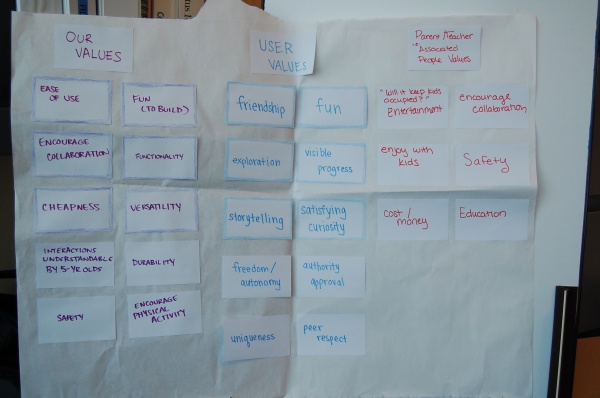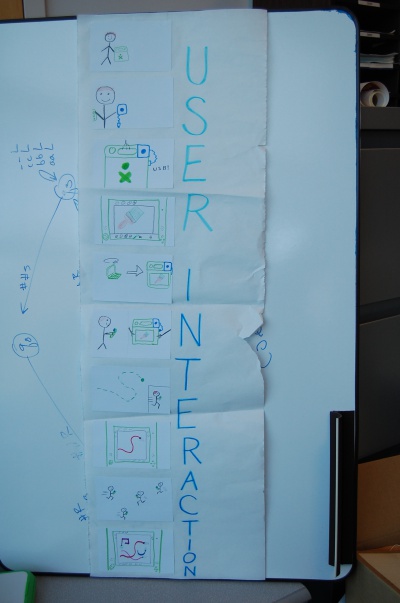Inertial navigation peripheral/Design phase: Difference between revisions
m ({{TOCright}}) |
(documentation) |
||
| Line 68: | Line 68: | ||
Creating a set of user values, designer values, and parent/teacher values gives us a lens through which we can evaluate our ideas. It also provides a basis for requirements that will lead to technical specifications. |
Creating a set of user values, designer values, and parent/teacher values gives us a lens through which we can evaluate our ideas. It also provides a basis for requirements that will lead to technical specifications. |
||
[[Image:NleeUserValues.jpg|600px|right]] |
|||
==== User values ==== |
==== User values ==== |
||
* friendship |
|||
* to be added once I copy off the poster! |
|||
* fun |
|||
* exploration |
|||
* visible progress |
|||
* storytelling |
|||
* satisfying curiosity |
|||
* freedom/autonomy |
|||
* uniqueness |
|||
* peer respect |
|||
==== Designer values ==== |
|||
* ease of use |
|||
* fun (to build) |
|||
* encourage collaboration |
|||
* functionality |
|||
* cheapness |
|||
* versatility |
|||
* interactions understandable by 5 year olds |
|||
* durability |
|||
* safety |
|||
* encourage physical activity |
|||
==== Parent/teacher values ==== |
|||
* "will it keep kids occupied?" - entertainment |
|||
* encourage collaboration |
|||
* enjoy with kids |
|||
* safety |
|||
* cost/money |
|||
* education |
|||
=== Interaction narrative === |
|||
Interaction narratives show how a user would interact with a product, highlighting changes that the product would make and clarifying what the design is and why it is compelling. |
|||
[[Image:NleeInteractionNarrative.jpg|400px]] |
|||
Revision as of 22:23, 3 October 2008
The first phase in our project is to look at various design considerations, in order to build a user-friendly, user-desired prototype.
Ideation and idea picking
Notes from this session can be found at Olin university chapter/OLPC peripheral development/90208
Initial characterization
The first questions we have to address are "who are our users?" and "what are our limitations?" Once both have been answered, brainstorming can begin.
Target users
- 10-12 years old
- have access to food, water, housing, and some form of electricity (i.e. XOs can be recharged)
- have either XS or direct internet access
Ideation
We started by describing what qualities an interaction with our creation should have, and then brainstorming ideas (rule #1: there are no bad ideas in phase 1 brainstorming) that would then be narrowed down. Considerations when narrowing the range of ideas include desired interactions, limitations of the XO, and budget/timeline.
What kind of interaction do we want?
- FUN!
- related to livelihood
- does it need to be tethered to the XO?
- encourage interactions between kids (collaborative)
- challenge
- something that can't already be done on an XO
What do we have to work with?
- microphone
- trackpad
- speakers
- input sensors
- USB
Brainstorming
- minesweeper
- compass
- inertial navigation
- pedometer
- karaoke
- music keyboard
- accessibility
- interactive globe
- abacus
- dummy GPS
- flow rate sensor
- weather sensor
- tablet for drawing
- geospatial art
- USB pet
- physical location tamagotchi
- USB furby
Idea refinement
After discussing various ideas and gauging team interest/enthusiasm, we narrowed our options down to three ideas:
- geospatial art
- USB pet
- mesh weather sensing
Final design idea: "geospatial art", the idea of making art on the XO by interacting with the physical world (running around)
User considerations
User values
Creating a set of user values, designer values, and parent/teacher values gives us a lens through which we can evaluate our ideas. It also provides a basis for requirements that will lead to technical specifications.
User values
- friendship
- fun
- exploration
- visible progress
- storytelling
- satisfying curiosity
- freedom/autonomy
- uniqueness
- peer respect
Designer values
- ease of use
- fun (to build)
- encourage collaboration
- functionality
- cheapness
- versatility
- interactions understandable by 5 year olds
- durability
- safety
- encourage physical activity
Parent/teacher values
- "will it keep kids occupied?" - entertainment
- encourage collaboration
- enjoy with kids
- safety
- cost/money
- education
Interaction narrative
Interaction narratives show how a user would interact with a product, highlighting changes that the product would make and clarifying what the design is and why it is compelling.

